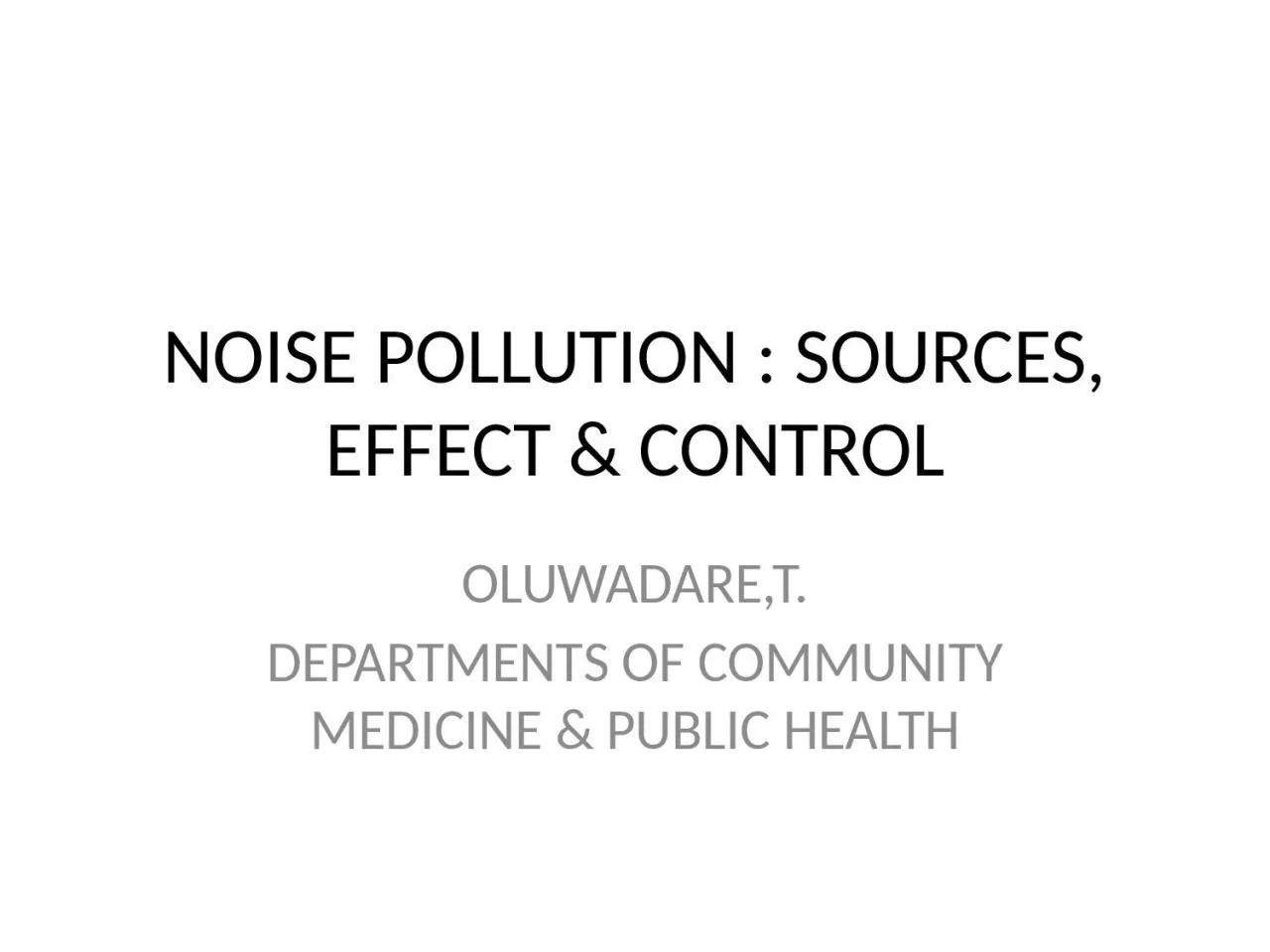

OLUWADARET DEPARTMENTS OF COMMUNITY MEDICINE amp PUBLIC HEALTH Introduction Noise is unwanted sound Wrong sound in the wrong place at the wrong time Noise has become a very important stress factor in recent time ID: 1029648
Download Presentation The PPT/PDF document "NOISE POLLUTION : SOURCES, EFFECT & ..." is the property of its rightful owner. Permission is granted to download and print the materials on this web site for personal, non-commercial use only, and to display it on your personal computer provided you do not modify the materials and that you retain all copyright notices contained in the materials. By downloading content from our website, you accept the terms of this agreement.
1. NOISE POLLUTION : SOURCES, EFFECT & CONTROLOLUWADARE,T.DEPARTMENTS OF COMMUNITY MEDICINE & PUBLIC HEALTH
2. Introduction Noise is unwanted soundWrong sound, in the wrong place, at the wrong time.Noise has become a very important stress factor in recent time.Noise pollution signify the vast types of sounds that are being produces in the modern life, leading to health hazards
3. Properties of soundNoise has two important propertiesLoudness or intensityFrequency The effect of sound is subjective, that is different people responds differently to perceived intensity rather than the loudness of the sound.
4. Properties of sound contd.Loudness loudness of noise is measured in decibels (dB).Normal conversation produces a noise of 60-65dBWhispering is 20-30 dBHeavy street traffic is 60-80dB.A daily exposure up to 85dB is about the limit people can tolerate without substantial damage to their hearing.
5. Properties of sound contd.Frequency Frequency is denoted in Hertz (Hz)The human ear can hear frequencies from about 20 to 20,000Hz , this range reduces with age and other subjective factors.Range of vibration below 20Hz are infra-audible and those above 20,000Hz are ultra-sonic.Phon is psycho-acoustic index of loudness, it takes into consideration intensity and frequency.
6. Noise measurement The basic instrument to study noise areSound level meter- measures the intensity of sound in dBOctave Band Frequency Analyzer- measures noise in octave bandAudiometer- measures hearing ability
7. Sources of noise Student activity Mention the different sources of noise
8. Effects of noise exposure The effects of noise exposure are of two typesAuditory effectsNon-Auditory effects
9. Effects of noise exposure Auditory effectsAuditory fatigue: It appears in the 90dB region and greatest at 4000Hz. It is associated with whistling and buzzing in the ear.Deafness: The hearing loss may be temporary or permanent. Repeated or continuous exposure to noise around 100dB and above may result in permanent hearing loss.
10. Effects of noise exposure Non-Auditory effectsInterference with speech: noise interferes with speech communication when it is between 300-500HzAnnoyance: neurotic people are more sensitive to noise than balanced people. Workmen exposed to higher intensity of noise in occupational capacities, were often irritated, short tempered and impatient.
11. Effects of noise exposure Non-Auditory effectsEfficiency: reduction in noise has been found to increase work output. Physiological changes: there are a number of temporary physiological changes occur in the human body as a result of exposure to noise. These are: Rise in blood pressureRise in intracranial pressureIncrease in heart rate and breathing Increase in sweating.Nausea Fatigue
12. Control of noise contd.Careful planning of citiesCities should be divide into zones with separation of areas concerned with industry and transportSeparation of residential areas from the main streets by means of green belt areas. House fronts should lie not less than 15 meters from the road and the intervening space should be thickly planted with trees and bushes.
13. Control of noise contd.Control of vehiclesHeavy vehicles should not be routed into narrow streets.Vehicular traffic on residential streets should be reduced.Indiscriminate blowing of horn and use of pressure horn should be prohibited.
14. Control of noise contd.Improve acoustic insulation of buildingInstallations that produce noise or disturb the occupants within dwellings should be prohibitedBuildings s should be sound-proof where necessary
15. Control of noise contd.Protection of exposed personsHearing protection is recommended for all workers who are consistently exposed to noise louder than 85 dB in the frequency bands above 150Hz.Workers must be regularly rotated from noisy areas to comparatively quiet posts in factories. LegislationEducation
16. THANK YOU